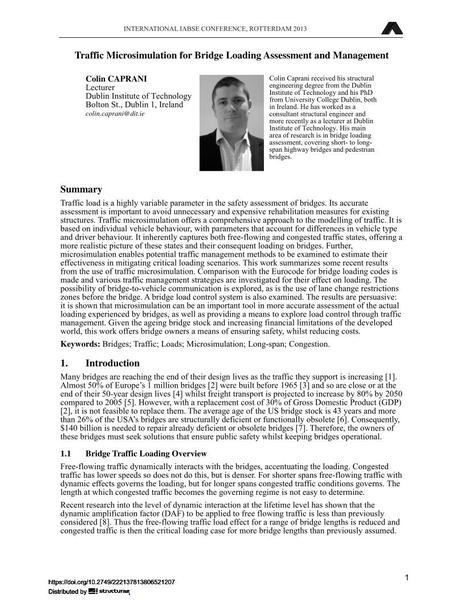Traffic Microsimulation for Bridge Loading Assessment and Management

|
|
|||||||||||
Bibliographic Details
| Author(s): |
Colin Caprani
|
||||
|---|---|---|---|---|---|
| Medium: | conference paper | ||||
| Language(s): | English | ||||
| Conference: | IABSE Conference: Assessment, Upgrading and Refurbishment of Infrastructures, Rotterdam, The Netherlands, 6-8 May 2013 | ||||
| Published in: | IABSE Conference, Rotterdam, May 2013 | ||||
|
|||||
| Page(s): | 478-479 | ||||
| Total no. of pages: | 8 | ||||
| Year: | 2013 | ||||
| DOI: | 10.2749/222137813806521207 | ||||
| Abstract: |
Traffic load is a highly variable parameter in the safety assessment of bridges. Its accurate assessment is important to avoid unnecessary and expensive rehabilitation measures for existing structures. Traffic microsimulation offers a comprehensive approach to the modelling of traffic. It is based on individual vehicle behaviour, with parameters that account for differences in vehicle type and driver behaviour. It inherently captures both free-flowing and congested traffic states, offering a more realistic picture of these states and their consequent loading on bridges. Further, microsimulation enables potential traffic management methods to be examined to estimate their effectiveness in mitigating critical loading scenarios. This work summarizes some recent results from the use of traffic microsimulation. Comparison with the Eurocode for bridge loading codes is made and various traffic management strategies are investigated for their effect on loading. The possibility of bridge-to-vehicle communication is explored, as is the use of lane change restrictions zones before the bridge. A bridge load control system is also examined. The results are persuasive: it is shown that microsimulation can be an important tool in more accurate assessment of the actual loading experienced by bridges, as well as providing a means to explore load control through traffic management. Given the ageing bridge stock and increasing financial limitations of the developed world, this work offers bridge owners a means of ensuring safety, whilst reducing costs. |
||||
| Keywords: |
bridges long-span traffic loads congestion microsimulation
|
||||
